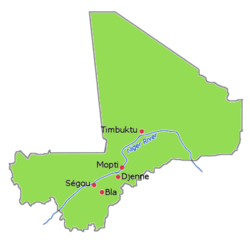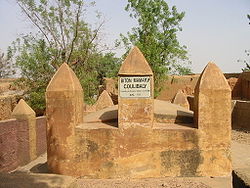
Ségou
About this schools Wikipedia selection
This content from Wikipedia has been selected by SOS Children for suitability in schools around the world. A quick link for child sponsorship is http://www.sponsor-a-child.org.uk/
| Ségou | |
|---|---|
 |
|
|
|
|
| Coordinates: 13°27′N 6°16′W | |
| Country | |
| Region | Segou |
| Cercle | Ségou Cercle |
| Population () | |
| • Total | 100,000 |
| Time zone | GMT ( UTC+0) |
Ségou (Seku, Segu) is a city in south-central Mali, lying 235 kilometres (146 mi) northeast of Bamako on the River Niger, in the region of Ségou. It was founded by the Bozo people in 1620, on a site about 10 kilometres (6.2 mi) from the present town. With 100,000 inhabitants, it is the third largest city in Mali.
Capital of the Bambara Empire in the past, Ségou is now the capital of Mali’s fourth largest administrative region of Ségou. It is known also as the city of “Balanzan”, named after the local tree Acacia albida. Segou has faced numerous conquests and changes of administration, but has always benefited from trade with nearby commercial centres such as Djenne and Timbuktu, and been an administrative center and commercial centre for cereal and cattle.
History
The city prospered after Biton Mamary Coulibaly became king in 1712 and founded the Ségou (or Bamana) Empire. Mungo Park became the first European known to have visited this city in 1796. The empire gradually declined and was conquered by El Hadj Umar Tall's Toucouleur Empire in 1861 (see battle of Segou), then by the French Army Colonel Louis Archinard in 1892.
Origin
Segou has contested origins. Some claim that the word Segou come from “Sikoro,” meaning to the foot of a shea butter tree. Others argue that it was named after Cheikou, a marabout who founded the city, while other theories support the claim that Segou was founded by the Bozo fishermen coming from the north, who established their villages along the Niger River.
The eleventh century CE saw an influx of the Soninke who were trying to escape from the expansion of the Ghana Empire, with Mandinga populations following. It is believed that it Kaladjan Koulibaly, founder of the Bambara Kingdom's Koulibaly dynasty established the first sedentary villages here at his time. The later Diarra dynasty moved the capital of the Bambara Kingdom to Segou.
Segou Koro
Segou Koro is located at about fifteen kilometres from Segou, on the road to Bamako. Segou Koro was created by the founder of the Bambara dynasty. During the 1600s, Bambara coming from Djenné, lead by Kaladjan Koulibaly settled down along the Niger River. Danfassari, Koulibaly’s son continued his father’s work by building his city there. After Koulibaly’s death, his eldest grandson Mamari also known as Biton, ruled the city and made it flourish. Nowadays the town pretty much conserves the tradition and architecture of the ancient city.
Bambara Kingdom
The Bambaras from Djenne with Kaladjan Koulibaly, established their nation along the Niger River, and founded the town of Ségou-Koro, the capital of the Bambara state. Bortolot (2003) says that Segou evolved from a simple social structure, characterized by hunting and farming, to a more complex city dominated by a dynasty system. One of Koulibaly’s descendants, Mamary Coulibaly, became the chief of the Bi-Ton, and later took the name Biton. Biton spread terror, organised the army and restructured the association into a city. He expanded the territory from Segou Koro to Timbuktu. Under his rule, the Macina and Djenne trading centers became a part of Segou. Timbuktu was not part of Segou. It remained autonomous and paid tribute to Biton. After Biton’s death in 1755, one of the Coulibaly family slaves, Ngolo Diarra, obtained power to control the Bambara kingdom and established the Diarra dynasty. Ngolo Diarra ruled Ségou until the nineteenth century. He moved the kingdom’s capital from Segou-Koro to Segou, close to the site of the current city. Diarra continued Biton’s conquest and extended the kingdom from Guinea to Timbuktu.
Conquest
In 1860, El Hadj Oumar Tall conquered the city and influenced the population to become Muslim. El Hadj Oumar Tall gave control of Segou to his son and successor Ahmadu, who ruled until 1890. The French colonial army invaded during the 1890s made Segou the administrative centre for the Office du Niger which was created in 1932.
Geography
Location
Ségou is situated 240 km from Bamako, on the Niger River and has a surface area of 64 947 km². The region has frontiers with Burkina Faso at the south-east, Mauritania at the north, Mopti, Mali at the east, Koulikoro, Mali at the west and Sikasso, Mali at the south.
Climate
The Segou region is characterized by a semi-arid climate and irrigated by two important waterways: the Niger and the Bani River. Segou has two seasons: a rainy season and a dry season. The rainy season starts in June and lasts about four months until September. Segou's dry season includes a cold period and a period of heat. The average yearly rainfall is about 513 mm. The harmattan is the dominant wind in the dry season and it blows from north to south. The monsoon blowing from south to north-west is more frequent during rainy season (hivernage).
Demography
Segou Region’s population was about 1,769,201 in 1998. With a rural population that is largely nomadic semi-sedentary or sedentary, their population consists of many ethnic groups such as Bambara, Bozo, Pul, Soninke, Malinke and Toucouleur. Bambaras are mostly farmers and are the most numerous ethnic group. Their language is Bambara or Djoula. The Bozos are the second most populous ethnic group. They typically live near the shore of the Niger river, in small towns of small houses. The Bozo economy is based on fishing. Bozo people have a monopoly on the transport system because of their knowledge of the Niger, its shallows and seasonal lakes, and are regarded as the masters of water. The Somono, also fisherman, are not a distinct ethnic group but a mixture of Bambara, Bozo and Soninke. The Malinké, Maninka, and Mandinka are closely related to Bambaras. They have the same costumes, religious beliefs and practices as Bambaras. The Marka, Saracollé or Soninke are merchants and warriors. The Soninke people are great travellers and Muslims, and have largely conserved their traditions.
Art and Culture
The Bambaras used to transmit their knowledge by oral tradition, hence much of their art and culture is unknown. Segou’s cultural heritage includes traditional musical instruments, wonderful griots, folkloric groups and the traditional masks and marionettes. The history of the Bambara state’s traditional religious practices are ambiguous. They practice animism and fetishism as cultural practices, and also totemic and monism (cult of ancestors). The most famous Segou handcrafts are based on pottery, weaving (blankets, wrappers and carpets), manufacturing of Bogolan ( a distinctive variation of Mud cloth), painting and sculpture. Segou is also regarded as the capital of Malian pottery with a large pottery district in Kalabougou situated on the left bank. Women make the pottery by hand with the clay coming from the Niger River and bring the finished works to the local Monday market. Segous also do weaving and it includes tapestries.
Architecture
Segou town has two architectural styles. The first style is the French colonial style, the second is traditional architecture; Sudanese and neo-Sudanese. The Sudanese style influenced public building and important residences. Monuments and great mosques are also built according to this style. Many of Segou's kings built imposing palaces in the cities over which they ruled and most of these buildings are in red clay. The materials used for building are generally quite poor and many of the buildings need to be restored to maintain their state.
Economy
Today, Ségou is known for its pottery, its market and its fishing industry. Attractions in the old town of Ségou-Koro included a mosque, Coulibaly's tomb and an ancient tree. In the city centre, the main landmark is the water tower.
The main economic activities of the Segou region are agri-business, cattle farming and fishing. The Segou people apply essential traditional farming methods. Segou produces the major part of Mali’s food including sedentary cattle farming. The economy is essentially informal as it is oriented towards the populations' primary needs, while industrial production is weak and based on the food industry. Large scale agribusiness consists of three factories, COMATEX, CMDT and SUKALA. Commerce consists mostly of the small scale exchange and sale by of products from the primary sector, sold weekly at the large Segou market, drawing customers from far outside of the city. The main products sold are vegetables, pottery, cotton, gold, leather, fruits, ovens, cattle and cereals.
People from Ségou
Notable people from Ségou include Adame Ba Konare, Fanta Damba, Garan Fabou Kouyate, and Mountaga Tall.
Maryse Condé's historical novel Segu tells the city's history from 1797 to its 1891 defeat by French Army.
Cercle
The Cercle of Ségou includes the urban commune of Ségou and 29 rural communes ( Pélengana, Sébougoubou, Konodimini, N'Gara, Massala, Sakoïba, Soignébougou, Cinzana, Samené, Dioro, Farakou-Massa, Kamiandougou, Diédougou, Koumandougou, Bellen, Baguidadougou, Farako, Sama-Foulala, Souba, Digandougou, Katiéna, Fatiné, Diouna, Markala, Dougabougou, Togou, Boussin, Sansanding et Sibila) totaling 554 villages and neighborhoods.
The cercle's 469,219 residents include Bambaras, Fulas (Fulani), Miniankas, Bozos, Somonos, Dogons and Soninkés.
Sister cities
 Angoulême, France, since 1984.
Angoulême, France, since 1984. Richmond, Virginia, United States.
Richmond, Virginia, United States.




